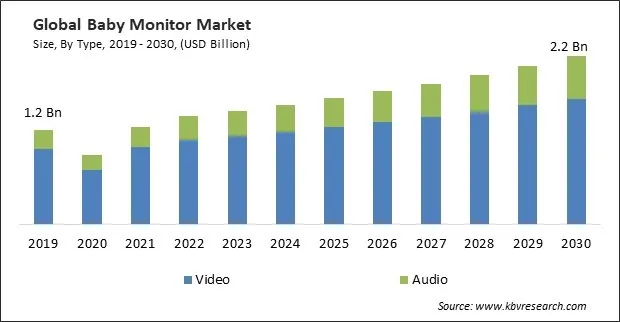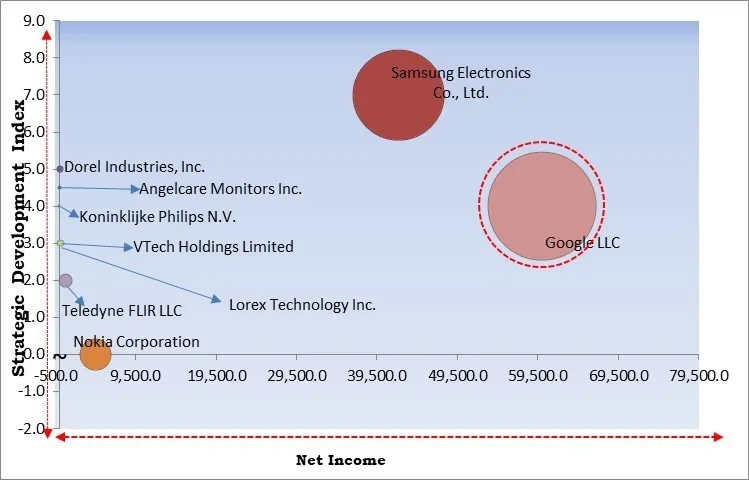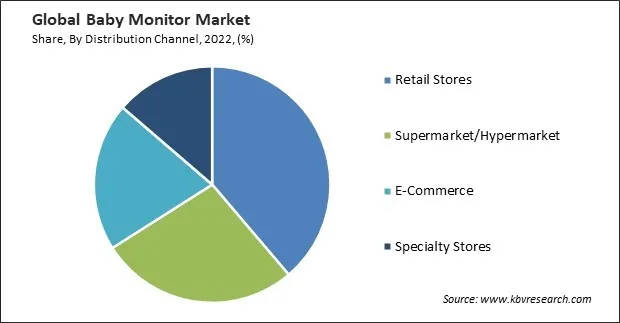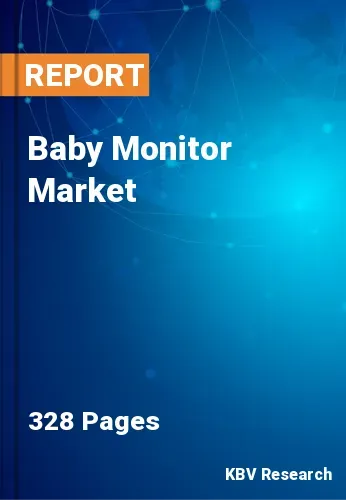The Global Baby Monitor Market size is expected to reach $2.2 billion by 2030, rising at a market growth of 5.8% CAGR during the forecast period. In the year 2022, the market attained a volume of 19,902.7 thousand units experiencing a growth of 6.4% (2019-2022).
Long working hours and parents' busy schedules in urban households in the Asia Pacific region are resulting in a growing dependence on remote monitoring of infants to ensure their security and maintain schedules. Consequently, the Asia Pacific region would achieve nearly 30% of the total market share by 2030. The convenience these products offer and constantly improving product features and options encourage consumers to opt for smart baby monitors. Parents in emerging economies, such as Malaysia, Thailand, and Indonesia, have become increasingly aware of the health and hygiene of their babies and are keen to spend more on better-quality products.

The major strategies followed by the market participants are Partnerships as the key developmental strategy to keep pace with the changing demands of end users. For instance,in October, 2023, Teledyne FLIR LLC entered a partnership with REP Marketing Solutions, to distribute its multi-layered physical security solutions to customers across the Mid-Atlantic region. The partnership provides Teledyne FLIR with an opportunity to expand its customer base in the Mid-Atlantic region. Moreover, in January, 2023, Koninklijke Philips N.V. signed a partnership with Masimo, to develop remote patient monitoring solutions. The partnership would facilitate physicians to access their patient's data instantly and provide solutions for the same without any hassle. Moreover,
Based on the Analysis presented in the KBV Cardinal matrix; Google LLC is the forerunner in the Market. Companies such as Samsung Electronics Co., Ltd., Teledyne FLIR LLC and Dorel Industries, Inc. are some of the key innovators in Market. In October, 2022, Samsung Electronics Co., Ltd. extended its partnership with Google, an American technology company, to develop smart home interoperability solutions. The partnership facilitates the customers of the two companies to exercise greater control over their devices.

One of the monitor's most significant technological advancements is incorporating video monitoring capabilities. Video monitoring provides an additional layer of reassurance and helps parents respond more effectively to their child's needs. Integrating smart connectivity and mobile apps has revolutionized how parents interact with these monitors. Also, Incorporating AI and ML technologies has brought intelligent capabilities to these monitors. These systems can learn and adapt to a baby's sleep patterns, recognize different sounds, and even provide insights into the child's behavior over time. The cumulative impact of these technological advancements has significantly expanded the market.
Employed parents, especially those who work outside the home, face the challenge of being away from their infants during working hours. These monitors offer a practical solution by enabling parents to monitor their child's activities remotely, providing peace of mind and allowing them to stay connected even when physically apart. For parents who utilize daycare services, these monitors offer a way to stay connected with their child's well-being while at the daycare facility. Video monitors, in particular, provide parents with visual reassurance and insights into their child's daily activities. Parents working night shifts or irregular hours benefit from these monitors that enable them to monitor their children's sleep patterns and activities during unconventional hours. Thus, the rise in employed parents has expanded the market.
A decline in birth rates may lead to longer product lifecycles for these monitors. Parents may continue using their existing monitors for extended periods, delaying the need for replacements or upgrades. This extended product lifecycle challenges manufacturers and retailers seeking consistent market growth. Competition among the manufacturers intensifies as the market size contracts due to declining birth rates. Companies may face increased competition for a smaller pool of customers, which can pressure pricing strategies and profit margins. The above factors will decrease the market growth in the coming years.
On the basis of type, the market is segmented into audio and video. The audio segment acquired a substantial revenue share in the market in 2022. Audio baby monitors are straightforward to use. They provide a clear and real-time audio feed, making them ideal for parents who prioritize simplicity and don't require video monitoring. Audio monitors offer a level of privacy that some parents prefer. Without a visual feed, there are no images to worry about addressing privacy and data security concerns. Audio monitors may experience less interference than video monitors, especially in environments with many electronic devices or competing signals.
By distribution channel, the market is segmented into retail stores, supermarket/hypermarket, e-commerce, and specialty stores. The supermarket/hypermarket segment registered a remarkable growth rate in the market in 2022. Supermarkets and hypermarkets are often one-stop shops for various household needs, including baby products. Purchasing these monitors while shopping for groceries or other essentials saves time and consolidates errands. These stores typically stock a variety of these monitors, providing options for different budgets and feature preferences. This can result in cost savings compared to specialized baby stores or online retailers.

Based on connectivity, the market is fragmented into wired and wireless. In 2022, the wired segment held a significant revenue share in the market. The direct wired connection ensures a stable and consistent signal between the camera and the monitor. Since wired monitors don't rely on radio frequencies or Wi-Fi, they are less susceptible to interference from other electronic devices, ensuring a clear and uninterrupted signal. Wired monitors often do not rely on batteries for power, reducing the need for frequent battery replacements or recharging. This can be convenient for parents who prefer a continuous, plug-and-play monitoring experience.
| Report Attribute | Details |
|---|---|
| Market size value in 2022 | USD 1.4 Billion |
| Market size forecast in 2030 | USD 2.2 Billion |
| Base Year | 2022 |
| Historical Period | 2019 to 2021 |
| Forecast Period | 2023 to 2030 |
| Revenue Growth Rate | CAGR of 5.8% from 2023 to 2030 |
| Number of Pages | 328 |
| Number of Table | 674 |
| Quantitative Data | Volume in Thousand Units, Revenue in USD Billion, and CAGR from 2019 to 2030 |
| Report coverage | Market Trends, Revenue Estimation and Forecast, Segmentation Analysis, Regional and Country Breakdown, Competitive Landscape, Porter’s 5 Forces Analysis, Company Profiling, Companies Strategic Developments, SWOT Analysis, Winning Imperatives |
| Segments covered | Type, Connectivity, Distribution Channel, Region |
| Country scope |
|
| Companies Included | Dorel Industries, Inc., Angelcare Monitors Inc., Summer Infant, Inc. (Kids2, Inc.), Samsung Electronics Co., Ltd. (Samsung Group), Koninklijke Philips N.V., Nokia Corporation, Teledyne FLIR LLC (Teledyne Technologies Incorporated), Google LLC (Alphabet Inc.), Lorex Technology Inc. and VTech Holdings Limited |
| Growth Drivers |
|
| Restraints |
|
Region-wise, the market is analysed across North America, Europe, Asia Pacific, and LAMEA. In 2022, the North America region registered the highest revenue share in the market. Due to the region's early adoption of advanced technologies, these monitors are widely accepted. In addition to monitoring their babies' movements remotely, these products allow parents to track them remotely. In addition to sending video clips of sounds and motion, the camera can let parents view them on a smartphone anytime. Furthermore, due to their high purchasing power, the population of this region is more inclined toward technological developments. This, in turn, stimulates the growth of the region's market.
Free Valuable Insights: Global Baby Monitor Market size to reach USD 2.2 Billion by 2030
The market research report covers the analysis of key stake holders of the market. Key companies profiled in the report include Dorel Industries, Inc., Angelcare Monitors Inc., Summer Infant, Inc. (Kids2, Inc.), Samsung Electronics Co., Ltd. (Samsung Group), Koninklijke Philips N.V., Nokia Corporation, Teledyne FLIR LLC (Teledyne Technologies Incorporated), Google LLC (Alphabet Inc.), Lorex Technology Inc. and VTech Holdings Limited
By Type (Volume, Thousand Units, Revenue, USD Billion/Million, 2019-30)
By Distribution Channel (Volume, Thousand Units, Revenue, USD Billion/Million, 2019-30)
By Connectivity (Volume, Thousand Units, Revenue, USD Billion/Million, 2019-30)
By Geography (Volume, Thousand Units, Revenue, USD Billion/Million, 2019-30)


This Market size is expected to reach $2.2 billion by 2030.
Advancements in technology of baby monitoring are driving the Market in coming years, however, Decline in birth rates across various regions restraints the growth of the Market.
Dorel Industries, Inc., Angelcare Monitors Inc., Summer Infant, Inc. (Kids2, Inc.), Samsung Electronics Co., Ltd. (Samsung Group), Koninklijke Philips N.V., Nokia Corporation, Teledyne FLIR LLC (Teledyne Technologies Incorporated), Google LLC (Alphabet Inc.), Lorex Technology Inc. and VTech Holdings Limited
In the year 2022, the market attained a volume of 19,902.7 thousand units experiencing a growth of 6.4% (2019-2022).
The Retail Stores segment led the Market by Distribution Channel in 2022; thereby, achieving a market value of $765.6 Million by 2030.
The North America region dominated the Market by Region in 2022, and would continue to be a dominant market till 2030; thereby, achieving a market value of $748.7 Million by 2030.
Our team of dedicated experts can provide you with attractive expansion opportunities for your business.

